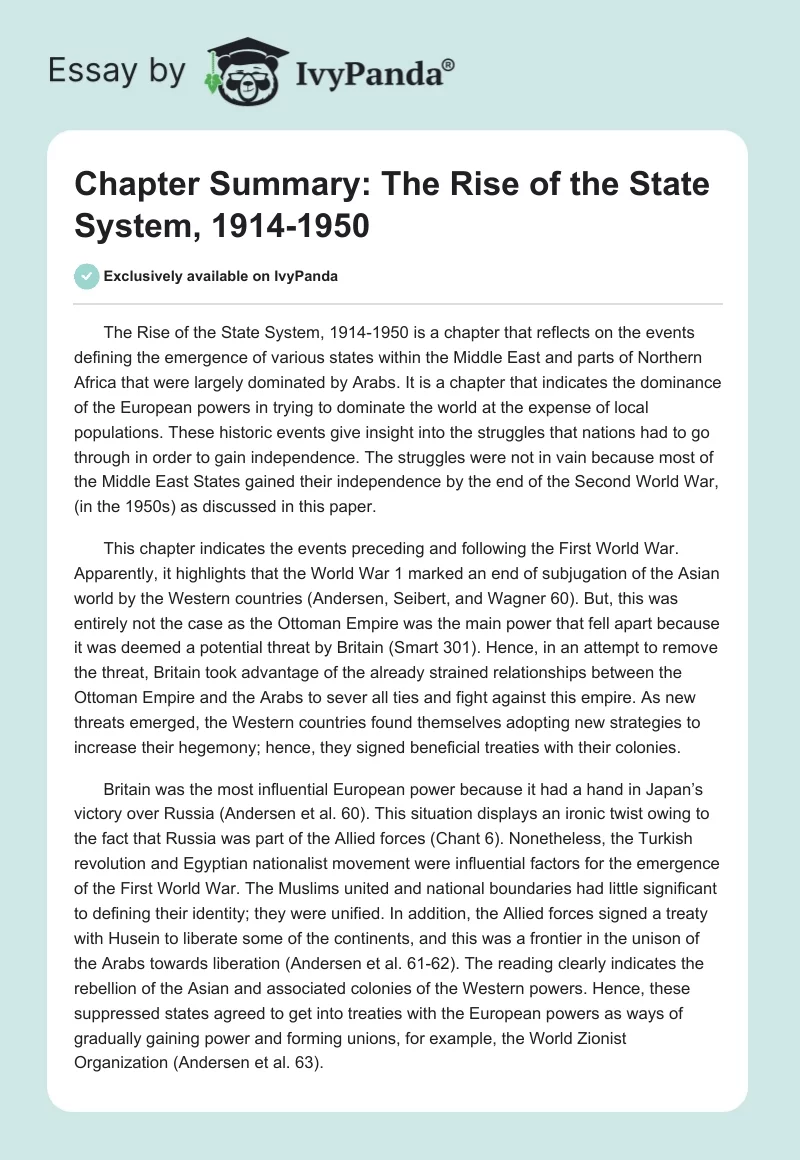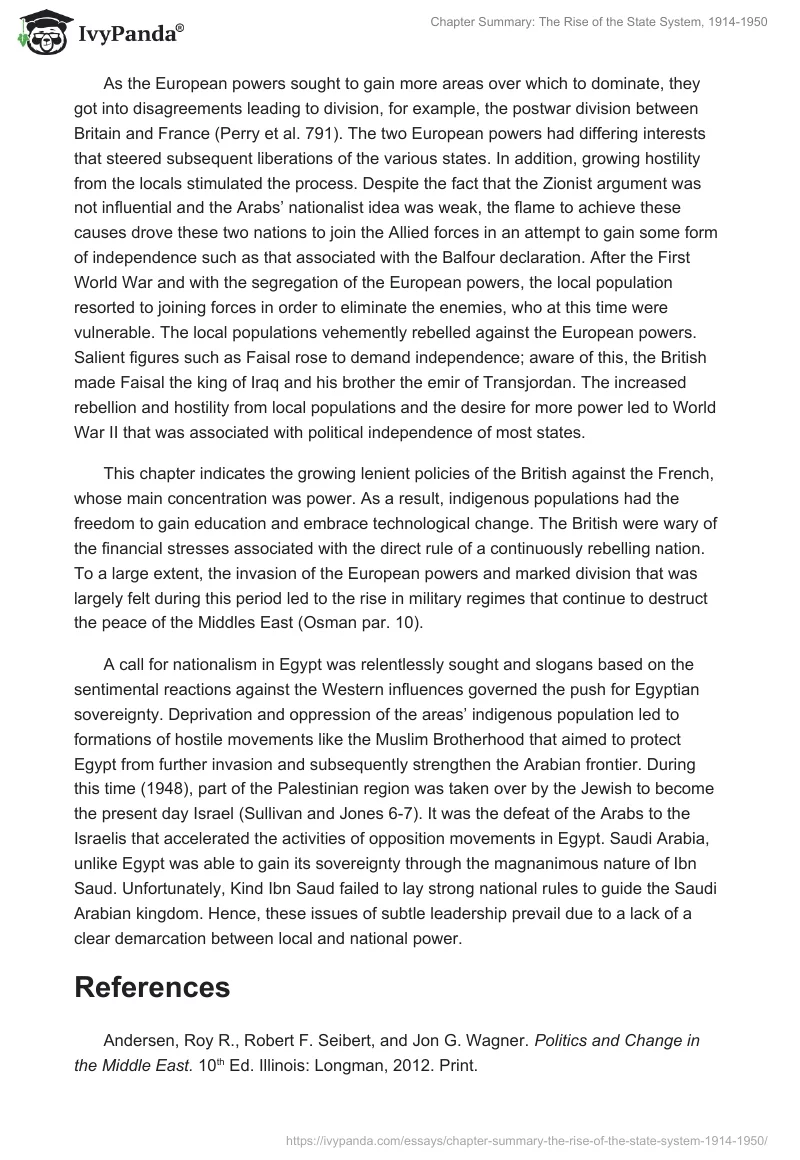The Rise of the State System, 1914-1950 is a chapter that reflects on the events defining the emergence of various states within the Middle East and parts of Northern Africa that were largely dominated by Arabs. It is a chapter that indicates the dominance of the European powers in trying to dominate the world at the expense of local populations. These historic events give insight into the struggles that nations had to go through in order to gain independence. The struggles were not in vain because most of the Middle East States gained their independence by the end of the Second World War, (in the 1950s) as discussed in this paper.
This chapter indicates the events preceding and following the First World War. Apparently, it highlights that the World War 1 marked an end of subjugation of the Asian world by the Western countries (Andersen, Seibert, and Wagner 60). But, this was entirely not the case as the Ottoman Empire was the main power that fell apart because it was deemed a potential threat by Britain (Smart 301). Hence, in an attempt to remove the threat, Britain took advantage of the already strained relationships between the Ottoman Empire and the Arabs to sever all ties and fight against this empire. As new threats emerged, the Western countries found themselves adopting new strategies to increase their hegemony; hence, they signed beneficial treaties with their colonies.
Britain was the most influential European power because it had a hand in Japan’s victory over Russia (Andersen et al. 60). This situation displays an ironic twist owing to the fact that Russia was part of the Allied forces (Chant 6). Nonetheless, the Turkish revolution and Egyptian nationalist movement were influential factors for the emergence of the First World War. The Muslims united and national boundaries had little significant to defining their identity; they were unified. In addition, the Allied forces signed a treaty with Husein to liberate some of the continents, and this was a frontier in the unison of the Arabs towards liberation (Andersen et al. 61-62). The reading clearly indicates the rebellion of the Asian and associated colonies of the Western powers. Hence, these suppressed states agreed to get into treaties with the European powers as ways of gradually gaining power and forming unions, for example, the World Zionist Organization (Andersen et al. 63).
As the European powers sought to gain more areas over which to dominate, they got into disagreements leading to division, for example, the postwar division between Britain and France (Perry et al. 791). The two European powers had differing interests that steered subsequent liberations of the various states. In addition, growing hostility from the locals stimulated the process. Despite the fact that the Zionist argument was not influential and the Arabs’ nationalist idea was weak, the flame to achieve these causes drove these two nations to join the Allied forces in an attempt to gain some form of independence such as that associated with the Balfour declaration. After the First World War and with the segregation of the European powers, the local population resorted to joining forces in order to eliminate the enemies, who at this time were vulnerable. The local populations vehemently rebelled against the European powers. Salient figures such as Faisal rose to demand independence; aware of this, the British made Faisal the king of Iraq and his brother the emir of Transjordan. The increased rebellion and hostility from local populations and the desire for more power led to World War II that was associated with political independence of most states.
This chapter indicates the growing lenient policies of the British against the French, whose main concentration was power. As a result, indigenous populations had the freedom to gain education and embrace technological change. The British were wary of the financial stresses associated with the direct rule of a continuously rebelling nation. To a large extent, the invasion of the European powers and marked division that was largely felt during this period led to the rise in military regimes that continue to destruct the peace of the Middles East (Osman par. 10).
A call for nationalism in Egypt was relentlessly sought and slogans based on the sentimental reactions against the Western influences governed the push for Egyptian sovereignty. Deprivation and oppression of the areas’ indigenous population led to formations of hostile movements like the Muslim Brotherhood that aimed to protect Egypt from further invasion and subsequently strengthen the Arabian frontier. During this time (1948), part of the Palestinian region was taken over by the Jewish to become the present day Israel (Sullivan and Jones 6-7). It was the defeat of the Arabs to the Israelis that accelerated the activities of opposition movements in Egypt. Saudi Arabia, unlike Egypt was able to gain its sovereignty through the magnanimous nature of Ibn Saud. Unfortunately, Kind Ibn Saud failed to lay strong national rules to guide the Saudi Arabian kingdom. Hence, these issues of subtle leadership prevail due to a lack of a clear demarcation between local and national power.
References
Andersen, Roy R., Robert F. Seibert, and Jon G. Wagner. Politics and Change in the Middle East. 10th Ed. Illinois: Longman, 2012. Print.
Chant, Christopher. Austro-Hungarian Aces of World War 1. Oxford: Osprey Publishing, 2002. Print.
Osman, Tarek. Why Border Lines Drawn with a Ruler in WW1 still Rock the Middle East. 2013. Web.
Perry, Marvin, Myrna Chase, James R. Jacob, Margaret C. Jacob, Jonathan W. Daly, Theodore h. Von Laue. Western Civilization since 1400: Ideas, Politics, and Society. 11th ed. Boston: Cengage Learning.
Smart, Ninian. World Philosophies. London: Routledge, 1999.
Sullivan, Denis J., and Kimberly Jones. Global Security Watch-Egypt: A Reference Handbook. Connecticut: Greenwood Publishing Group, Inc, 2008.


